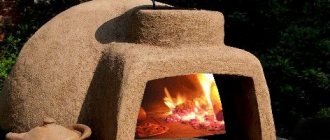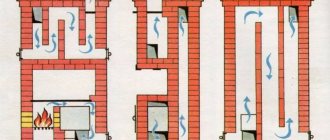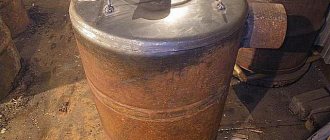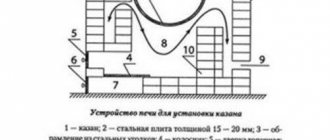One of the most famous types of bell furnaces is the Pompeii furnace. For many centuries it has been used by people to prepare family lunches and dinners. Nowadays such an oven can often be found in restaurants, pizzerias and bakeries. Among wood-fired pizza lovers, it is called a pizza oven.
Currently, the Pompeian oven is regaining its popularity - it is increasingly becoming an interesting alternative to barbecue. It is installed in dachas, in the courtyards of private houses, in gazebos and on terraces.
In this article, you'll learn how to build your own wood-fired pizza oven in seven steps. If you dream of being able to enjoy a fragrant crust at home at any time, then this is the article you have been waiting for a long time.
However, a word of warning... Building this pizza oven will take you some time - a few days, and for most people perhaps weeks. But for a true wood-fired pizza lover, this project is the best way to spend your time and creativity.
Interesting! The pleasure of homemade wood-fired pizza is a worthy reward for your efforts.
Although you will have to invest your time, building a stove will not require significant financial expenditure. If you get creative with the process, you can get it under $100. In the example below, the stove was built from recycled wood and other reclaimed materials. And even if you have to purchase new building materials from hardware stores, you still won't spend more than $500. That's less than what you'd spend if you bought one slice of pizza from a restaurant every day for a year.
Points to pay attention to before starting construction
Before you begin to study the step-by-step instructions, it is important that you have a clear idea of the end result. The article describes the technology for manufacturing a small portable oven for cooking pizza, which will move on a small cart. This option is ideal for those who do not have construction experience, but really want to bake pizza at home in a wood-burning oven.
How much free space do you have for your oven? Would you like to be able to move it or should it be stationary? Be sure to answer these questions before starting assembly. Ovens designed for restaurants can have a total hearth area of 1,900 to 2,700 inches. We recommend that you first measure the area where construction is planned.
Interesting! This will give you an idea of what the assembly plan and finished product will look like.
Depending on where you live, check that you won't need planning permission.
Cost: Of course, the larger the oven, the higher the cost. If this is your first time undertaking this type of construction, then using our instructions you can build a stove from reclaimed wood and recycled materials for less than $100. But if your oven is for a restaurant or commercial use, the price could rise to $10,000.
Tools and Materials: Our build plan requires a minimum set of tools and materials. If you plan to build a more substantial brick kiln, you will already need firebricks, fireclay, fireproof fabric and other materials.
A small oven will require these tools.
- Hammer.
- Nails or screws (for cart).
- Wheels/rollers (for trolley).
- Gloves.
- Bag or bucket.
- Plywood.
- A bag of cement.
- A bag of vermiculite.
- Water.
Required skills: Before starting work, you need to objectively assess your skills. With the proper patience, anyone can master the skills necessary to make such a stove. But if you do not have independent experience in making such products, then it is better to start with a simple stove design, which we describe in our instructions. If your plans are for a more ambitious project, then you should consider bringing in an experienced friend or relative who can help if problems arise.
Interesting! Despite the fact that most amateurs use this oven for baking pizza, it is also quite suitable for preparing many other dishes. You can cook almost anything in a wood-burning oven - bake bread, meat, fish and much more.
So, if you decide to build your own stove in your backyard, great! Follow our instructions carefully and get started!
Essential elements
Foundation. It is indispensable when constructing such a structure. Instead of such a base, a reinforced concrete slab can be used, which is laid on a gravel bed.
Stand. It sits on a bed of gravel, allowing you to raise the structure to a comfortable height, making cooking easier. The stand itself is a square box with brick or concrete walls.
Table. We are talking about a flat surface installed directly on the stand. In essence, this is reinforced concrete, the thickness of which is about 20 cm. Such an element must withstand the weight of the furnace and provide high-quality thermal insulation of the hearth.
Peculiarities
In traditional Italian pizzerias, a Pompeian oven can be heated for months, the flame in it is almost never extinguished, and while baking pizza, the temperature in it can reach 350º C. To prepare various dishes, the temperature in the hearth can range from 70 to 400 degrees. For lovers of grilled dishes, the Pompeian oven allows you to install a Tuscan grill in the hearth. To do this, the coals are raked closer to the mouth and then a special metal grate with legs is placed there.
The main features that distinguish the Pompeian stove from other types of stoves.
- The chimney is located at the “entrance” to the stove.
- The height of the entrance arch is about 60% of the total height of the furnace chamber.
- Cold air is drawn into the chamber from below and immediately enters the flame. Having become hot, it rises up, goes around the arch of the chamber and goes down again, after which it is pulled out into the chimney.
- The width of the entrance arch is approximately equal to the height of the dome. This ratio provides good draft in the chamber, with little heat loss.
- It is preferable to heat the stove with tree species that produce little soot - alder, cherry, apple tree, olive.
The main cooking styles are:
Cooking in the oven
Roasting:
Pompeian brick oven heat of 350 degrees or higher is used to bake pizza, pizza-like flatbreads and some types of appetizers, all of which take just a couple of minutes to cook. The goal of this type of cooking is to completely fill the floor and dome with heat, create a large "bed" of coals, and maintain a large fire as the flames reach the top of the dome. There are two ways to tell when your oven is ready to bake your pizza. Firstly, when the oven dome itself has cleared up and there is no visible black soot. At this point you should move the heat to the side, continuing to keep the heat high as the flame reaches the middle of the oven. Alternatively, if you are using an infrared thermometer, the oven floor should be between 350-400 degrees. Pizzas are baked right on the floor next to the fire. Leave the oven fully open and add wood every 15-20 minutes to maintain a high flame.
Baking:
Bake (250 degrees and below) is used for baking breads, desserts, small cuts of roasted meats, beans and legumes, and pasta dishes at regular oven temperatures. After the Pompeii oven is fully fired, carefully remove the hot coals and clean the oven. Your Russian oven can now cook accurately and consistently with the heat stored in the oven dome and floor, maintaining a constant temperature for a long time. Using this type of cooking, you can bake either one full batch of bread, or several baths of different types of bread, but in smaller quantities. Close the oven door tightly to trap heat inside.
Roasting:
A Russian brick oven or Pompeian oven makes an excellent grill. By raking a layer of hot coals to the front of the oven and placing a rack in the oven, you can enjoy grilling gorgeous meats.
Also, try experimenting with different pots and pans. A grill pan preheated in the oven gives your cuts of meat a beautiful seared pattern, while a terra cotta plate and steel plate make fried potatoes taste completely different than deep frying.
If a Russian brick stove or a Pompeian brick stove was laid out for you by a good, competent stove maker, then such a stove will take a central place not only in everyday life, but also on those days when you have friends over. A skillful hostess will be able to offer something new and unforgettably delicious for every such meeting! Experiment! And we will build a good Russian stove!
How does a Pompeian stove differ from a Russian one?
Differences in the design of Pompeian and Russian stoves are due to their purpose and the climate of the area. In Italy, the birthplace of Pompeian stoves, due to the warm climate, it is used mainly for cooking, rather than for heating a room. Therefore, traditionally, when building a Pompeian oven, a lighter stone is used, which quickly heats up to the desired temperature and then immediately releases heat.
The task of a Russian stove is to heat the room in which it is located for a long time. Therefore, its design is made so that the heated air moves deep inside the oven. It takes a Russian stove much longer to heat up to a high temperature and requires more fuel for this. But thanks to this design, it is able to retain heat for a long time.
Interesting! The rapid heat transfer of the Pompeian furnace can be compensated for by using high-quality insulating materials during the construction of the dome and base.
The most obvious difference between the Pompeii oven is its rounded shape. The absence of corners ensures uniform heating, which is necessary for cooking.
Principle of operation
The heating principle inside the Pompeian system is based on two hot air flows - convective from the hearth and reflected from the ceiling.
Expert opinion
Nikolay Davydov
Stove maker with 15 years of experience
Inside the oven, the temperature is regulated without human intervention. This is done due to the physical properties of the combustion products: if the firewood flares up strongly, the gas released by the fire when exiting the system presses the incoming air flow so that the intensity of firewood combustion decreases, and therefore the temperature in this unique design is normalized.
Principle of operation
An important role in the design is played by the dome, which emits heat flows, thereby heating the surface of the food, and consequently preparing its upper layers. That is why in these systems the pizza becomes perfectly cooked.
Technical characteristics of furnaces
The main similarity between Pompeii and Russian stoves is the ratio of the sizes of the stove arch and dome. For both types of ovens, the widest part of the arch is equal to the height of the arch of the inner chamber. The height of the vault usually ranges from 60 to 80 percent of the entire stove dome. The optimal width of the internal base of the firebox is about 1 meter. A wider chamber will heat up worse and retain heat poorly, and a small firebox is not convenient to use and will not allow you to cook dinner for a large number of people.
The Pompeian stove differs primarily in the location of its chimney. It is located at the top, immediately behind the entrance arch. Thanks to this, hot air moves through the chamber from bottom to top, quickly and evenly baking the dish. The height of the chimney is selected depending on where the stove is located. If the stove is located under a canopy, then the pipe must be extended beyond the roof, otherwise the entire space under the canopy will be filled with smoke.
Interesting! If the stove is installed in an open place, the chimney can be up to 1 meter high.
Light the stove with straw and wood. Alder, cherry, apple, oak, and ash produce the least amount of smoke. The stove should not be heated with fuel pellets, coniferous wood or damp wood. When such fuel burns, a lot of soot is formed, which will spoil both the taste of the finished dish and the appearance of the stove itself.
Device
The design of the Neapolitan stove is easy. Making a Pompeii stove yourself is not difficult. The components of this stove are:
- The base of the Pompeian furnace (foundation).
- A table that is necessary for comfortable cooking of any dish.
- A hemispherical vault or otherwise called a dome. Another component of the furnace is the under. Under (the bottom of the oven or its floor) is the place where the fire is lit and the pizza or other dish is cooked.
- The fourth part is the chimney pipe.
- Outer casing.
- Thermally insulated layer.
These are the main components of a Pompeian oven that do not require professional intervention for their construction.
Pompeii clay oven
You can build a Pompeian oven not only from brick, but also using clay as a material for the dome. This is not a particularly difficult process. The foundation and base of the furnace are laid in the usual way, and coarse sand is used as a model for the dome. A clay mixture is laid out on top of it. It is, of course, safer to purchase clay at a specialized or hardware store. All other stages of making a clay oven are no different from the usual design. After the manufacture of the dome is completed, a chimney is installed on it, which can be made of any material, including brick.
Interesting! Is any oven suitable for making pizza? Unfortunately no.
To prepare good pizza, the oven must maintain the required temperature - this is 320-350 degrees, and for Neapolitan pizza the oven warms up to 450-500 ° C. The higher the temperature in the oven chamber, the juicier the finished pizza and the faster it bakes. Baking for too long will cause the dough to become dry and hard. One extra minute in the oven equals 1% of the moisture lost from the pizza. Therefore, a wood-burning oven is the ideal way to prepare the right pizza, proven by many years of Italian tradition. A well-made Pompeii oven should bake a pizza in 90 seconds. The main role in this process is played by the material from which it is built. Professionals who know their stuff always prefer a clay oven.
Clay is a natural, durable material that can serve for a very long time and retain its properties. The story of one clay oven is known, which was made in Italy in 1988 for a family pizzeria. This oven still regularly bakes excellent Neapolitan pizza for residents and guests of the city.
A clay pizza oven will have the required heat capacity only if it has been fired for a long time and all proportions of the dome are observed when constructing it. This oven is truly capable of preparing an airy, crispy and at the same time tender pizza crust. You should be wary of counterfeits, which flood the market in Russia.
Interesting! Currently, unscrupulous manufacturers who make non-clay stoves add various impurities to the materials. This makes it possible to slightly improve the heat-intensive characteristics, but when heated, such a stove can release toxic substances that have a detrimental effect on human health.
If you want to purchase a real Italian clay oven, you need to find out where the production is located. If it is not made in Italy, it is better to refuse such a purchase. Be sure to study the composition of the materials from which it is made. Lastly, it can be a good idea to ask the seller if their oven has passed the pizza test. Will this oven cook pizza in 90 seconds at 350 degrees?
Stages of work
How to make a Pompeii oven with your own hands from brick? Designing an Italian stove is quite simple - the main thing is desire and the availability of all the necessary materials. The work is carried out in 4 stages:
- Arrangement of a hearth and pedestal for a dome with an arch
- Forming a model from clay or earth
- Construction of the dome
- Dome lock installation
The whole order is clearly depicted in the diagram below:
Stages of work
Scheme and drawing
Scheme and dimensions
This figure shows the main stages of the construction of a pompeii, and also indicates all the dimensions of the parts of the Italian stove. The pizza oven, the drawing of which is shown above, does not require many skills to build - the main thing is to select the right materials.
Foundation
The structure definitely needs a high-quality foundation; a reinforced concrete slab with a thickness of 15-20 centimeters is ideal for this role. For proper waterproofing, you can use a two-layer roofing felt. The foundation plays a fairly important role - it ensures the stable condition of the entire structure and allows you to install very heavy structures on it, in this case it is a Pompeian brick oven, which has enormous weight.
The foundation can be made according to this scheme
Cinder block pedestal
You need to install a pedestal on the base, on which the stove itself will be installed. A pedestal for a pompeii is also called a table. You can lay it out of brick, but it is easier and faster to build it from ordinary concrete cinder blocks - they are cheaper than other materials and have good stability compared to other materials.
You need to build the base using regular masonry, as in the photo below:
Construction of the foundation
Three walls will allow the tabletop to remain stable, and inside the resulting opening you can stack dishes or firewood; this part of the pompeii will serve as a mini-warehouse. After the three walls are folded, the tabletop is installed on them.
Tabletop
As a countertop, you can use a concrete or calcium silicate slab. Some people purchase marble slabs, and the pedestal is made of natural stone. Residents of the Krasnodar region used slabs from dismantled dolmens for Pompeii ovens whenever possible.
Example of making a countertop
Furnace laying
The construction of the Pompeii furnace itself is the most important part of the work. It begins with laying a hearth made of fireclay refractory bricks. The bottom is the name given to the lower part of the stove, which is the bottom where the wood will burn while the pompeii is running, so it should be laid out beautifully and as compactly as possible. The most suitable herringbone styling:
This option is most preferable
As you can see in the photo above, in addition to the hearth itself, you need to lay out the side of the entire structure and the pedestal for constructing the arch from fireclay bricks.
After this, you need to decide how the dome model will be made, on top of which the masonry will be made. The model can be a hemisphere made of earth or clay soil, formwork made of cardboard or wood, or a radial model made of wooden plates. The easiest way to make a model is from clay or earth:
Layouts on which you can make masonry
After the dome model is made, masonry can begin. Since it will be the inner layer of the entire structure, you should use only refractory fireclay bricks that can withstand extreme temperatures. Some owners decide to use a hinged support instead of a model; this simplifies the laying process, but increases the duration of all work:
Another masonry method
Continuation of masonry
When laying a brick dome, it is necessary to maintain its spherical shape, since it is the basis for good heating inside the Pompeian oven. For convenience, you can use refractory brick halves, which should be prepared in advance by cutting with a grinder and a stone disc. Follow safety precautions when cutting bricks:
- Use a mask, it can be purchased at a pharmacy;
- Be sure to wear safety glasses and gloves;
- Brick should only be cut with a stone disc;
- The cutting process takes place in the “pull” mode so that the brick does not jump out from under the disk.
Make sure the dome is made correctly
In order to correctly install the Pompeii stove with your own hands, keep the drawings and dimensions close to you during the work. Lay alternate rows of domes around the sphere, finishing each row of masonry before starting the next. In each subsequent row there will be 1.5 fewer bricks, so before you make a Pompeian stove with your own hands, be sure to keep blanks of 0.3-0.7 bricks on hand.
Completion of the dome masonry
Front view
Construction of a chimney
The chimney is laid out over the hole that was prepared during the construction of the structure. So the temperature inside it will be low; it can be made from ordinary brick masonry. The beginning of the work should be the installation of the arch:
Place for chimney
When building a Pompeian stove, some install a chimney made of galvanized steel. It doesn’t look so beautiful, but there is no need for work on its construction and you can save a lot on bricks.
Metal chimney
Thermal insulation of the furnace
On top of the masonry made of refractory bricks, a clay coating is made, on which thermal insulation 5-10 centimeters thick is laid on top. Mineral or basalt wool will serve best in this role.
Thermal insulation of the furnace
Next comes a layer of cement-sand or cement-lime plaster. After the thermal insulation has been completed, facing work can be carried out.
Furnace lining
When all the work on constructing the dome, installing thermal insulation and plastering has been completed, it is possible to carry out facing work that will make the stove visually attractive and consistent with the design conditions of the backyard.
Expert opinion
Nikolay Davydov
Stove maker with 15 years of experience
The type of cladding is largely determined by the location of the structure. If the system is installed outdoors, it is best to cladding it with mosaic or clay, or a high-quality cement-sand mixture.
Drying
After constructing the structure, it needs to be allowed to dry; the solution usually dries within 3-4 days, after which the first kindling can be done, which becomes the final stage of the work.
First kindling
After the entire structure has been erected, the first firing of the Pompeii furnace is necessary, which will serve as a strengthening process for it. Experts recommend heating the structure daily for a week to strengthen all layers. This is done in the following order:
- In the first fire, you need to fuse 2 kilograms of paper or 3 kilograms of straw inside the combustion chamber;
- In the second firebox, 3 kilograms of straw and 1 kilogram of wooden chips and sticks are burned;
- In the third firebox you can burn 4 kilograms of wood chips;
- The fourth fire allows you to burn one dry log;
- In each subsequent fire, the number of logs burned increases by one;
If the first kindling is carried out incorrectly, the entire structure may dry out and crumble, which will lead to the destruction of the structure.
Types of Pompeian stove, advantages and disadvantages
The Pompeian oven is known under different names - Italian, Roman, Neapolitan, Tuscan. The designs of its varieties may have slight differences. For example, the Tuscan oven has a higher dome, thanks to which you can cook almost any dish in it. But their main characteristic feature is that such ovens are ideal for baking bread and pizza. Of course, meat, fish and other products are also perfectly cooked in a Pompeii oven, but the aromatic, crispy and juicy pizza cooked in it is something that will forever remain in your heart.
Advantages of the Pompeian stove.
- Rapid heating to high temperature. You can bake pizza within 30 minutes after lighting the flame.
- Sufficient heat capacity. The stove is able to retain heat long after the wood has burned out.
- Very fast baking. Thanks to the high temperature that the oven can maintain, pizza is baked in it for no longer than 2 minutes.
- Compactness. The Pompeian stove can be conveniently placed in the yard, under a canopy or on the terrace.
- Aesthetic appearance of the stove.
In addition, the design of the Pompeian furnace is quite variable. Currently, stoves are manufactured that are connected to a barbecue or grill.
Interesting! Some ovens allow you to regulate and maintain a constant temperature; in such an oven you can cook a huge variety of dishes.
Flaws.
- Price. Construction of a solid furnace will require financial costs for materials.
- Foundation. A medium to large sized Pompeian stove will be quite heavy. For such a structure you will have to lay a solid foundation.
- Design features. When building a furnace, it is important to maintain all proportions of the dome and burn it correctly. This process will require some skills, as well as a patient and careful approach.
But all the effort and financial costs invested in such a project will certainly reward you with the special pleasure of homemade pizza made by yourself. In addition, having a Pompeian oven in the courtyard of your house, you will always know what to treat your guests with.
In conclusion, here are the recommendations of a specialist - Nikolai Davydov, who has 15 years of experience in manufacturing stoves of various designs:
“The Pompeian clay pizza oven is a fairly simple structure. If the technology is followed, anyone can build a high-quality product. It is important to consider features that are universal for any stove designs: ensure good thermal and waterproofing, and pay attention to the lining - this will protect your stove from natural factors (rain and snow).”
Conclusion
Construction of a Pompeii furnace is a troublesome task, but I have given you a detailed description of the complete cycle of creating a structure from scratch, and there will be no difficulties. The video in this article shows ovens of different sizes, but the technology is the same everywhere. If you have any questions or know simpler instructions, write in the comments and we’ll discuss your option.
A well-finished stove will be a true decoration of your yard.
Project selection
Taking into account the configuration of the dome, two types of Pompeian oven are distinguished. The first type is called Tuscan. Its dome height and radius have the same values. The Neapolitan dome has a height 20% less than the radius.
This oven is used for preparing various types of dishes.
The Tuscan stove is considered universal due to its higher arch. It perfectly cooks meat, stews, soups and pies. Neapolitan design has a narrow specialization. It is ideal for preparing various baked goods. Experts recommend choosing the Tuscan option.
As for the dimensions, the internal diameter of the oven should not be less than 110 cm. Otherwise, it will be inconvenient to cook in it.
A Tuscan oven can have different sizes, but its proportions must remain the same. For example, the height of the arch should be 60% of the dome, the width of the hole for storing fuel should also be calculated based on the total height of the structure.
The chimney should be placed at the front of the stove
This is especially important for our climatic conditions. After choosing a project and determining the location of the entire structure, you can begin purchasing materials and subsequent construction
How does it work?
It is important to understand the furnace structure before moving on to the construction phase. The operating efficiency of the equipment depends on the technical features
Temperature changes in the oven are self-regulated due to cyclic changes in gases, which is a characteristic feature and is perfect for baking baked goods and pizza. The dome of the structure is one of the main elements in the organization of work, accumulating heat energy emanating from the fire. During the combustion of solid fuel, two gas flows interact in the dome cavity:
- The first is convection. The flow is directed from the firebox.
- The second is reflected. Gas streams reflected from the walls of the dome itself.
First firing
Before lighting the stove for the first time, you must make sure that all materials are completely dry and the concrete or mortar has set. The longer you let the concrete dry, the stronger it becomes. You can wrap the structure in salophan or a damp cloth to prolong drying time.
During the first ignition, the water remaining in the masonry turns into steam, and can lead to cracks at this stage
For this reason, it is important to let the oven sit until it is completely dry. Heating of the oven itself must be done gradually
This also applies to brick and stone ovens. When starting the fire for the first time, you need to light a small fire and gradually increase the load of wood. Try not to use large firewood as this can cause the heat to build up quickly. The initial kindling should be spread over a 6 hour period. After you first fire up the fireplace, it should be carefully inspected for signs of cracks in weak points. In subsequent burns, you can use larger logs and heat the oven to its full potential.
What is real pizza?
Nowadays, pizza has become popular in many countries. Each contributed to the creation of the recipe, which is why such varieties as American pizza and French pizza are known. Italy is considered the birthplace of this masterpiece.
There is no single history of the creation of the recipe, since the prototype was created back in the Middle Ages, but the funniest is the version that states that pizza was invented by contemporaries in order to “empty” the refrigerator.
Products that had been lying on the refrigerator shelves for quite a long time were laid out on a flatbread made of unleavened dough: cheese, salami, mushrooms, lettuce, tomatoes. Naturally, with this approach there cannot be a real single recipe. This explains the variety of types of pizza, differing in composition.
Pizza making process
Financial aspects
The high cost of the Pompeii stove is explained by several factors, and the first of them is the cost of the material. We are talking about fireclay bricks, which are much more expensive than conventional materials. Secondly, despite its small size, the structure has considerable weight. Therefore, it will have to be equipped with a strong foundation. It won't be cheap.
It is necessary to take into account the need to raise the stove by about 1 m for ease of use. To do this, you need to lay out a brick stand on which the main structure will be assembled. This further increases financial costs.
Costs can be reduced slightly if you use any materials available on the farm when creating the stand. These could be fragments of floor slabs, pieces of building blocks, and even old bricks.
The speed of construction should also be taken into account. If you do everything yourself, the cost of building the stove will decrease slightly, but the time will increase significantly.
Construction report
The construction of the stove, which the author built for the first time in his life, took 7 evenings, 2-3 hours each. For a specialist, work here is 4-5 full days. In the meantime, the seams on one side were sanded and the position of the chimney was confirmed. All that was left was to decide to cut out the roof.
And now it comes to the first kindling. After completing the pipe, it became clear that the traction was excellent. We decided to slowly heat it all day and bake pizza in the evening.
By evening, the stove was running at full capacity, and nothing burst or cracked. The pace was measured with a pyrometer and so on. The author did not believe that the minced meat needed to be cooked for 60 seconds, so he kept it for 3-4 minutes. The bottom half closest to the coals burned a little. Everything is delicious - the taste is different from cooking in an electric oven.
DIY assembly
The first step is to prepare a solid foundation. It is better to do this in the summer, when there is minimal rain. But precipitation cannot be completely excluded, so a waterproofing film will not be superfluous.
Markings are made at the location of the entire structure and a pit is dug. Its depth should not be less than 350 mm. A formwork made of wooden boards is assembled along the walls of the pit, which is then covered with plastic film. It will become the basis of the waterproofing cushion.
A small amount of medium-fraction crushed stone is poured on top of the polyethylene, and a layer of sand no more than 100 mm thick is added on top. All this is covered with film on top. The waterproofing pad is poured with prepared concrete.
It is recommended to fill the foundation in 3 stages. Between each of them no less than a spirit of days must pass.
As soon as the level of the solution reaches the edge of the formwork, reinforcement is made. After this, the foundation must be left alone for 3 weeks. During this time it will finally settle down.
Drawing of a Pompeii oven
Pedestal with table top
This oven element is easiest to assemble from cinder blocks. They are inexpensive and easy to process. The height of the pedestal is selected taking into account the height of the user. It should be sufficient for comfortable work. The minimum value is 800 mm.
The shape of this element should be U or H-shaped. With a side length of 1200 mm, there will be 3 cinder blocks on each side of the base.
Initially, the pedestal is assembled without using a solution. The blocks are connected to each other using wire. Then their position relative to the foundation is verified using a building level and other measuring instruments. If everything is in order, then cement mortar is poured into the holes of the blocks.
After three days you can assemble the tabletop. This work consists of the following stages:
- Assembly of formwork up to 150 mm high.
- Covering the bottom with waterproofing material.
- Assembly of a reinforced frame on waterproofing with a cell pitch of 50 mm.
- Pouring concrete into the formwork and leveling it.
It takes 3 weeks for the countertop to finally gain strength. If you neglect this recommendation, cracks will appear in the concrete during operation and it may collapse.











